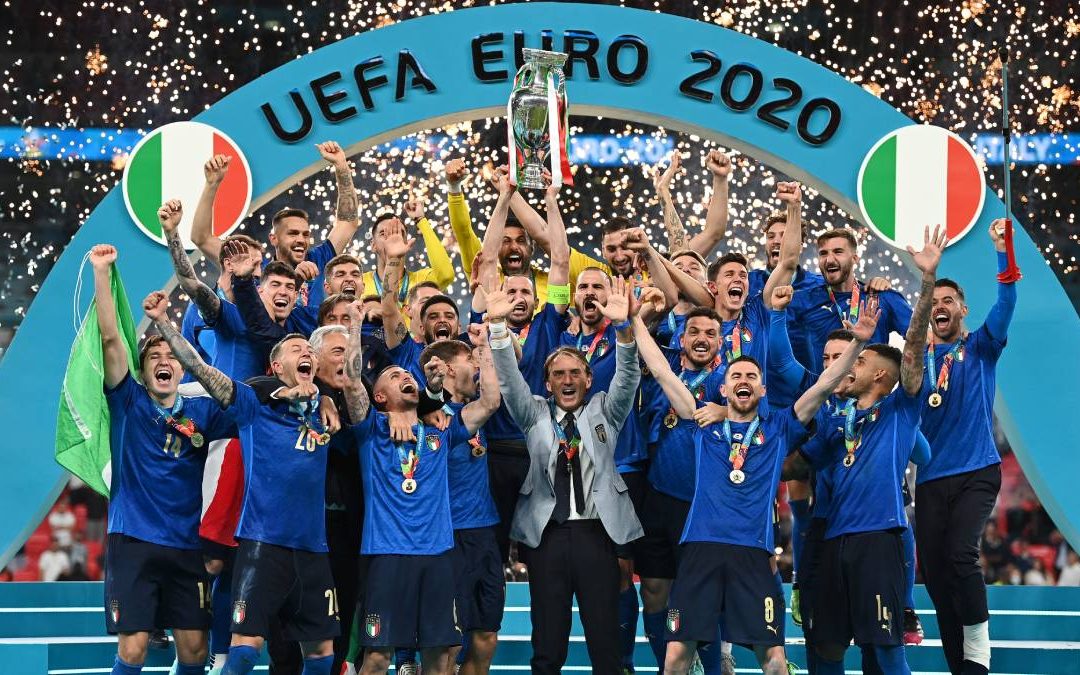Sunday, July 11 2021 was a historical day for Italians as they celebrated their big win of the Euro 2020 Soccer Cup, a year after it was initially scheduled due to the pandemic, by beating England on their home turf at London’s Wembley Stadium. After a month-long tournament and a tense European championship game, the blue-adorned Italian team sealed the deal with a 3–2 win, while securing their first crown since 1968. After missing the World Cup in 2018, the Italians came back with a vengeance and stole the win from the English who were hoping to secure their first major trophy since winning the World Cup at home in 1966. While the celebration of this win by the Italians showcases their passion for the sport, it is worth exploring the genesis of soccer in Italy and its connection with the Italian culture.
Soccer’s arrival in Italy dates back to the end of the 19th century, when British sailors were doing business in Italian ports. During their breaks, they would play games on the ports and in doing so, got the curious attention of the public. It took the Italians, who were new to football at the time, some time to understand and learn how to play the game. The origins of Italian soccer can be traced back to 1887 when Eduardio Bosio, a bookkeeper from Nottingham returned to Turin with a leather ball and set up the first Torino football and Cricket Club. In 1893, the Genoa club was formed and holds the title of the oldest club still playing today.
It is believed that soccer’s roots in Italy predate back to 1200–1300AD when the sport was born in Florence, as “historic Florentine football”, known as the “Calcio Storico Fiorentino” or “Calcio in Livrea” in old Florence. Later, during the 16th Century, this was one of the many competitions and pastimes among the local nobleman including wealthy aristocrats and popes. A combination of rugby and football, the Calcio Storico is regarded as one of the world’s most dangerous sports as it was born right during the Roman times when Gladiators used to fight in arenas and kings came up with violent sports for enjoyment.
Although its popularity began to fade in the 17th century, the Calcio Storico was revived in the 1930’s as a recognized sport under the rule of Benito Mussolini. Since then, the Calcio Storico has become an annual event that is held in the Piazza Santa Croce with new precautions introduced to prevent death for participants. Today, the Calcio Storico is dubbed as the father of modern soccer, American football and Rugby. The Italian football federation (FIF) was set up in 1898 with the initial goal of having fun. FIF evolved into the Italian Federation for the Game of Soccer (FIGC) which was in turn responsible for creating the first Italian championship. Other soccer clubs later sprouted throughout Italy and supporter groups began to form everywhere. Italians were engaged in a ‘kickaround’ of a ball, can or piece of paper anywhere they could: in chapels, courtyard estates, parks, squares and beaches. The Azurri followed in 1910, adopting the name of ‘Azure’ (blue), the color of the House of Savoy (Casa Savoia) and in so doing, set the tone for the team’s colors. The first victory at the World Cup came in 1934 and confirmed Italy as one of the greatest national teams of all time.
Italy’s passion for the sport has been showcased by past presidents and sports commentators, with its success turning the 1980s and 1990s into the golden years of Italian soccer. During this period, the luckiest people would go to the stadium. Others sat in front of their couches, gathered in parks with a portable radio pressed to their ears or hung out in cafes and bars the next day talking about the sport. The 1982 Gold Cup win helped position the Italian team as the best league in the world. Today spectators for the greatest Italian soccer clubs can soak in the passionate and absorbant atmosphere of the matches at cutting edge energy efficient locations such as the Allianz Stadium or at the San Siro stadium, considered by many the “Church of Soccer” and the largest in the country, guaranteed to get the heart racing. Soccer is very much ingrained in the heart and soul of the Italian people while being intricately connected to their culture.


Recent Comments